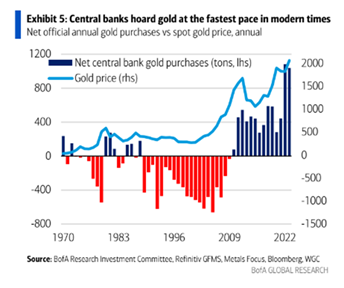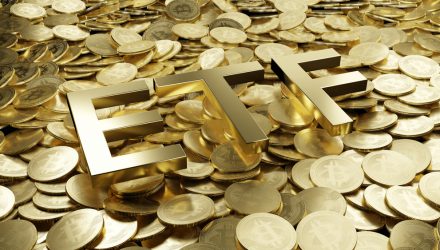Gold prices have shot up to historic highs – outshining broader markets and driving up demand for gold ETFs.
Investors often use gold ETFs to diversify away from stocks and bonds. Gold has the lowest correlation to the S&P 500 of all asset classes. The precious metal has also proven a popular hedge against geopolitical risk (of which there is plenty) and, at times, against inflation.
Global gold ETFs suffered their ninth straight month of outflows in February, but the trend started to reverse in March. Both the SPDR Gold Trust (GLD) and SPDR Gold MiniShares Trust (GLDM) have seen bid-up demand over the past month despite suffering net outflows for the first quarter.
Smaller ETFs: Time to Shine
GLD dominated over the last 30 days with net inflows of more than $950 million and total returns of 12.8% year-to-date – roughly tracking the price of gold bullion itself. GLDM was the second most popular, bringing in more than $350 million in new money, with shares up 13% so far this year.
These two products are practically identical, but GLDM typically trades at a lower share price than GLD, with an expense ratio of 0.10%. This makes it one of the cheapest on the market and the better choice for newer, smaller retail investors looking to buy and hold from a strategic standpoint.
GLD has a heftier cost of 0.40% but remains the most liquid gold ETF. It is the more tactical choice for investors wanting to trade in and out of gold or rebalance their positions in bulk. They need liquidity, which GLD’s heavier trading volume provides.
Meanwhile, the iShares Gold Trust Micro (IAUM), the lowest-cost physical gold ETF on the market at just 0.09%, saw net inflows. Others like the abrdn Physical Gold Shares ETF (SGOL) and VanEck Merck Gold Trust (OUNZ) also enjoyed net inflows over the past four weeks.
| ETF Name | Ticker | 1-Month Net Flows ($M) | Expense Ratio |
| SPDR Gold Shares | GLD | 951.84 | 0.40% |
| SPDR Gold MiniShares Trust | GLDM | 358.74 | 0.10% |
| VanEck Junior Gold Miners ETF | GDXJ | 72.77 | 0.52% |
| abrdn Physical Gold Shares ETF | SGOL | 62.03 | 0.17% |
| iShares Gold Trust Micro ETF | IAUM | 18.62 | 0.09% |
| iShares MSCI Global Gold Miners ETF | RING | 7.08 | 0.39% |
| VanEck Merk Gold Trust | OUNZ | 5.71 | 0.25% |
(As of April 12, 2024)
This compares to last year when spot gold performed well, but most gold ETFs still suffered outflows.
Who’s Buying?
The federal funds rate has peaked, and the prospect of falling rates and a weaker dollar have caused gold prices to spike. Many households have missed out on the rally – the third major gold rally in two decades – and are now under-invested.
Demand for jewelry remains robust in emerging markets like India and China. About half of all demand for gold stems from gold jewelry, while a quarter comes from investments. China‘s recovery has lit a fire under gold. Given the collapse of the nation’s property sector and equity market, Chinese buyers have faced geopolitical fears and few alternatives.
Central banks are also either snatching up or hoarding gold in droves – at the fastest pace in recent history.

(As of April 12, 2024)
That’s a significant chunk. Central banks account for roughly a fifth of all the gold mined throughout history.
Not (Just) Your Grandfather’s Gold?
Gold has long had a reputation for being the ultimate old-school, safe-haven play during periods of extreme market distress. But it’s no longer just an old-school concept.
Even Costco is getting in on the action now – selling up to $200 million in gold bars per month.
State Street’s latest Gold ETF Impact Study showed that more millennials are embracing gold as an investment. In fact, they are now the dominant demographic holding gold in their portfolios – overtaking both Gen X and Baby Boomers. They’re doing so primarily through gold ETFs.
Millennials had a higher average allocation to gold at 17% – compared to Gen X and Boomers’ exposure of just 10%. Millennials also expressed a greater appetite for gold ETFs – with 69% saying gold ETFs are the best way to invest. That compares to 55% among Boomers and 35% for Gen X.
Bitcoin ETFs: Taking a Bite Out of Gold?
Spot bitcoin ETFs saw enormous demand right out of the gate, even as the gold rally picked up steam. The combined assets of all 11 spot bitcoin ETFs have surged to over $50 billion—nearly a third of all gold ETF assets under management.
Most bitcoin ETFs have soared more than 50% since their inception in early January, but the long-term correlation between gold and bitcoin is historically low—0.03 or so—with bitcoin being about nine times more volatile than gold.
Whether cryptocurrencies will gain widespread acceptance as a legitimate asset class among wealth managers and other asset allocators remains to be seen. Bitcoin is not yet vying for the same long-term investor dollars as gold, but Bank of America and Wells Fargo are starting to offer spot bitcoin ETFs to wealth management clients.
We’ll continue to keep a close eye on gold and bitcoin as the two alternative investment styles gain traction.
For more news, information, and strategy, visit the Gold, Silver, and Critical Minerals Channel.








